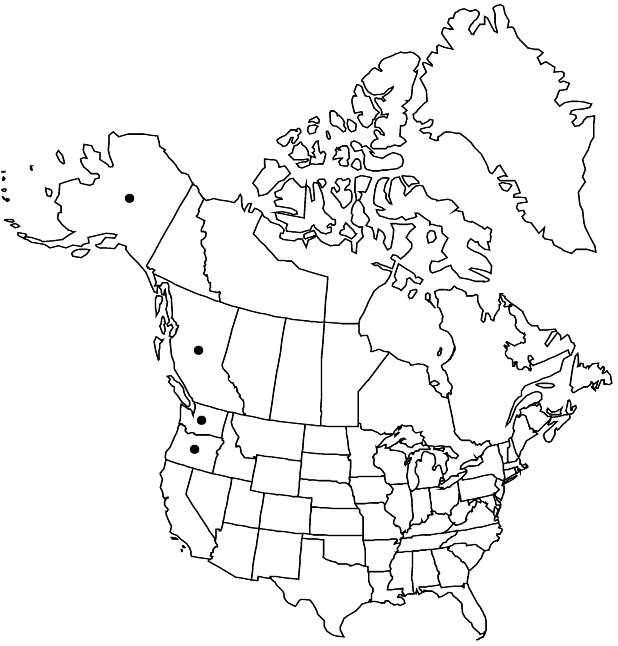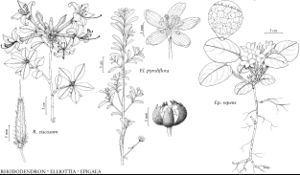Difference between revisions of "Elliottia pyroliflora"
J. Arnold Arbor. 59: 336. 1978 ,.
FNA>Volume Importer |
imported>Volume Importer |
||
| (3 intermediate revisions by 2 users not shown) | |||
| Line 10: | Line 10: | ||
|name=Cladothamnus pyroliflorus | |name=Cladothamnus pyroliflorus | ||
|authority=Bongard | |authority=Bongard | ||
| + | |rank=species | ||
|publication_title=Mém. Acad. Imp. Sci. St.-Pétersbourg, Sér. | |publication_title=Mém. Acad. Imp. Sci. St.-Pétersbourg, Sér. | ||
|publication_place=6., Sci. Math. 2: 155, plate 1. 1832 (as pyrolaeflorus) | |publication_place=6., Sci. Math. 2: 155, plate 1. 1832 (as pyrolaeflorus) | ||
| Line 16: | Line 17: | ||
|name=Leiophyllum pyroliflorum | |name=Leiophyllum pyroliflorum | ||
|authority=(Bongard) Dippel | |authority=(Bongard) Dippel | ||
| + | |rank=species | ||
}} | }} | ||
|hierarchy=Ericaceae;Ericaceae subfam. Ericoideae;Elliottia;Elliottia pyroliflora | |hierarchy=Ericaceae;Ericaceae subfam. Ericoideae;Elliottia;Elliottia pyroliflora | ||
| Line 40: | Line 42: | ||
-->{{#Taxon: | -->{{#Taxon: | ||
name=Elliottia pyroliflora | name=Elliottia pyroliflora | ||
| − | |||
|authority=(Bongard) Brim & P. F. Stevens | |authority=(Bongard) Brim & P. F. Stevens | ||
|rank=species | |rank=species | ||
| Line 55: | Line 56: | ||
|publication year= | |publication year= | ||
|special status= | |special status= | ||
| − | |source xml=https:// | + | |source xml=https://bitbucket.org/aafc-mbb/fna-data-curation/src/2e0870ddd59836b60bcf96646a41e87ea5a5943a/coarse_grained_fna_xml/V8/V8_925.xml |
|subfamily=Ericaceae subfam. Ericoideae | |subfamily=Ericaceae subfam. Ericoideae | ||
|genus=Elliottia | |genus=Elliottia | ||
Latest revision as of 22:47, 5 November 2020
Shrubs, 0.5–3 m, ± spreading; older twigs with copper-colored, shreddy bark, twigs of current season green, glabrous or sparsely hairy. Leaves alternate or seemingly whorled at ends of twigs; petiole 1–4 mm; blade elliptic to oblanceolate, (1.5–)2–5 × 0.6–1.4 cm, base cuneate, margins flat, apex mucronate, surfaces glaucous. Inflorescences terminal, solitary flowers or 2–3-flowered cymes, 2–4 cm; bracts leaflike, lanceolate, 10–15 mm, margins entire. Pedicels 5–10 mm, with 1–2, persistent bracteoles distally. Flowers: calyx lobes 5, lanceolate, 7–10 × 2–4 mm, apex acute, ciliate along margins especially basally; corolla 5-lobed, petals pinkish or copper colored, narrowly elliptic, 10–15 mm; stamens 8(–10); filaments glabrous; anthers 1.7–2 mm; style (persisting in fruit), curved or recurved, 10–12 mm. Capsules 5–6-parted, spheroidal, 5–8 mm, finely pitted, glabrous. Seeds 0.5–0.8 mm, testa with conspicuous cells. 2n = 22.
Phenology: Flowering Jun–Jul.
Habitat: Moist, coniferous forests and associated habitats in mountainous regions with cool temperatures and high rainfall, especially stream banks, bog edges, tree clumps, and forest edges in subalpine parkland
Elevation: 0-2500 m
Distribution

B.C., Alaska, Oreg., Wash.
Discussion
Elliottia pyroliflora has a wider geographic and elevational range than E. racemosa; it is considered difficult to grow.
Selected References
None.
